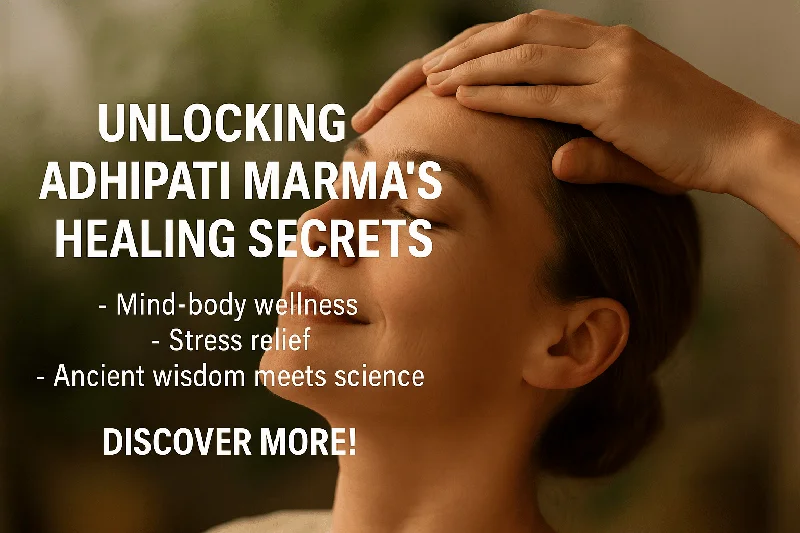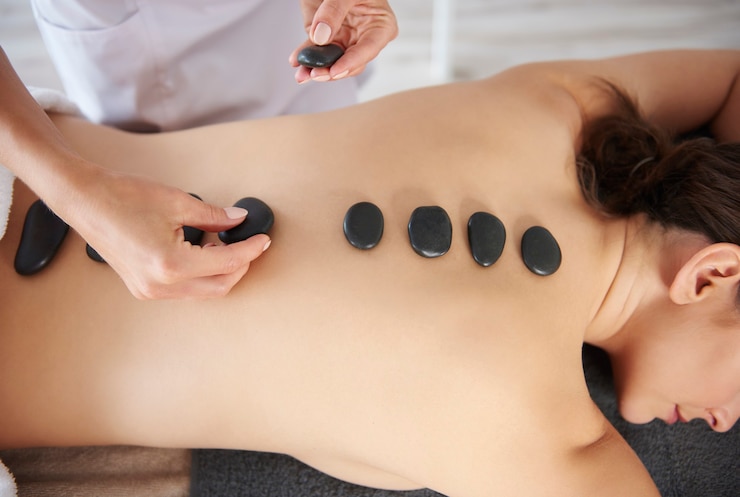Ask Ayurvedic doctor a question and get a consultation online on the problem of your concern in a free or paid mode. More than 2,000 experienced doctors work and wait for your questions on our site and help users to solve their health problems every day.
Shop Now in Our Store
Adhipati Marma: A Comprehensive Guide to the Science and Practice

Adhipati Marma, often referred to as the “crown” or “master” marma point, holds a revered place in traditional Indian medicine systems such as Ayurveda and Siddha. It is commonly located at the crown of the head and is believed to serve as a pivotal energy center for governing the physical, mental, and spiritual equilibrium of an individual. While traditional sources celebrate Adhipati Marma for its profound role in promoting clarity and balance, modern healthcare professionals are increasingly examining this point through the lens of science, looking for physiological explanations and possible therapeutic applications.
In this comprehensive guide, we will explore Adhipati Marma from a scientific perspective, summarize peer-reviewed research on its potential health benefits, and discuss practical applications supported by clinical practice. We will also provide considerations for use, share tips for safely exploring Adhipati Marma techniques, and highlight the importance of consulting healthcare professionals when integrating any new modality into a wellness routine.
Table of Contents
-
Introduction to Marmas and Adhipati Marma
-
Historical and Traditional Significance
-
Scientific Perspectives on Adhipati Marma
-
Modern Research and Evidence
-
Potential Benefits and Applications
-
How to Stimulate Adhipati Marma Safely
-
Precautions, Risks, and Considerations
-
Frequently Asked Questions (FAQ)
-
Conclusion and Call to Action
-
Disclaimer
1. Introduction to Marmas and Adhipati Marma
Marmas Defined:
In Ayurveda, the term “marma” refers to vital energy points on the body. These points are said to be intersections where muscles, veins, bones, ligaments, and joints meet, creating locations of heightened sensitivity and potential therapeutic influence. The concept is somewhat analogous to acupressure or acupuncture points in Traditional Chinese Medicine.
Adhipati Marma at a Glance:
-
Location: Commonly placed at the crown of the head (the vertex), recognized in some texts as being anatomically close to the anterior fontanelle (the bregma region in anatomical terms).
-
Meaning: Derived from Sanskrit, where “Adhi” implies “superior” or “chief,” and “pati” implies “lord” or “master.” Hence, Adhipati Marma translates to the “chief” or “master” marma, underscoring its importance.
-
Primary Focus: This point is associated with mental clarity, enhanced cognition, and spiritual awareness according to Ayurvedic literature.
2. Historical and Traditional Significance
Adhipati Marma’s significance spans centuries of traditional medical practice. References can be found in foundational Ayurvedic texts, such as the Sushruta Samhita and the Charaka Samhita, which designate it as a paramount site of prana (life force). Ancient healers believed that stimulating this marma could offer relief from stress, improve concentration, and align one’s spiritual energy.
Traditional Applications
-
Meditation and Yoga: Practitioners frequently place their focus on the crown area to achieve deeper states of meditation.
-
Marma Therapy: Gentle pressure or massage at the Adhipati Marma is believed to help with insomnia, stress, and headaches.
-
Spiritual Practices: In some traditions, the crown of the head is linked to the Sahasrara chakra, implying spiritual awakening and self-realization.
Though these applications are grounded in Ayurvedic philosophy, modern science is only beginning to investigate how such practices might correlate with neurophysiological mechanisms, including potential influences on neural pathways responsible for stress response.
3. Scientific Perspectives on Adhipati Marma
Neuroanatomical Correlations:
From a scientific viewpoint, the crown area (where Adhipati Marma is located) houses critical parts of the parietal lobes, just above key structures that govern sensory integration. Researchers exploring the impact of cranial acupuncture and other forms of head-based stimulation propose that gentle pressure in this region may influence certain neural circuits linked with emotional and cognitive processes.
Possible Mechanisms of Action:
-
Stimulation of Cranial Nerves: Although not directly in contact with cranial nerves, manipulations near the scalp may exert a subtle effect on nerve endings or cranial structures, potentially modulating pain or stress responses.
-
Impact on Stress Hormones: Preliminary studies in integrative medicine suggest that techniques involving scalp massage or acupressure can modulate cortisol levels (the body’s primary stress hormone).
-
Autonomic Regulation: Gentle, sustained pressure may shift the nervous system from a sympathetic “fight-or-flight” state toward a parasympathetic “rest-and-digest” dominance, promoting relaxation.
These hypotheses are still under investigation, and their applicability to Adhipati Marma specifically requires further randomized controlled trials.
4. Modern Research and Evidence
The direct mention of “Adhipati Marma” in peer-reviewed Western medical literature is scarce. However, several studies on related topics offer potential insights:
-
Scalp Acupressure Trials: Research in the Journal of Acupuncture and Meridian Studies (2019) discovered that scalp acupressure could lead to measurable reductions in anxiety among nursing students preparing for exams. While not identical to marma therapy, this suggests a possible overlap in therapeutic mechanisms.
-
Massage Therapy Meta-Analysis: A 2018 meta-analysis in the International Journal of Neuroscience found that cranial and head massages helped regulate cortisol levels and improved subjective well-being in participants.
-
Brain Wave Studies: Early pilot studies indicate that gentle stimulation around the cranial region can alter alpha and theta brain waves, potentially enhancing relaxation and mental clarity. Although these findings need further exploration, they open the door to new lines of research examining the possible neurophysiological basis behind Adhipati Marma practices.
Despite these studies, conclusive evidence directly linking Adhipati Marma stimulation to measurable health improvements remains limited. Large-scale, high-quality clinical trials are needed to validate any definitive benefits.
5. Potential Benefits and Applications
Though still under scientific scrutiny, practitioners and advocates of Adhipati Marma therapy often report the following potential benefits:
-
Stress Reduction: Traditional Ayurvedic belief holds that stimulating Adhipati Marma can help release tension. Modern parallels include findings that scalp stimulation can lower cortisol and promote relaxation.
-
Enhanced Mental Clarity: Individuals may experience improved focus and reduced mental fatigue. This aligns with research on brain wave modulation in scalp-based therapies.
-
Headache Relief: Some people with tension headaches find short-term relief through gentle pressure at the crown. Future research may validate these anecdotal accounts with empirical data.
-
Better Sleep Quality: Because of its relaxing nature, regular stimulation of this marma point might support better rest, although large-scale studies are still lacking.
-
Aid in Meditation Practices: Spiritual practitioners often mention deepening of meditative states when focusing on the crown. While personal experiences vary, the potential synergy between meditation and gentle cranial stimulation merits further scientific exploration.
6. How to Stimulate Adhipati Marma Safely
If you are interested in exploring Adhipati Marma stimulation, it is crucial to do so with an emphasis on safety and proper technique. Here are some guidelines:
-
Consult a Professional: Seek advice from a certified Ayurvedic practitioner, massage therapist, or healthcare provider well-versed in marma therapy.
-
Gentle Touch: Start with light, circular motions or gentle tapping over the crown. Avoid applying forceful or prolonged pressure.
-
Mindful Breathing: Practice deep, slow breathing during marma stimulation to enhance relaxation.
-
Duration: An initial session might last 1–3 minutes, gradually increasing to 5–10 minutes as you become comfortable.
-
Listen to Your Body: If you experience discomfort, dizziness, or any adverse reaction, discontinue immediately and consult a healthcare professional.
7. Precautions, Risks, and Considerations
While Adhipati Marma techniques are generally considered low-risk, certain precautions are advisable:
-
Existing Medical Conditions: Individuals with migraines, head injuries, or neurological disorders should consult a physician before attempting any self-stimulation.
-
Contraindications: Those with recent cranial surgery or open head wounds should avoid pressure in this region until fully healed.
-
Professional Expertise: For individuals seeking to incorporate Adhipati Marma stimulation into a broader therapeutic regimen, a consultation with an integrative or Ayurvedic health professional is highly recommended.
-
Evidence Gaps: While anecdotal and preliminary research findings are promising, large-scale studies have yet to establish definitive treatment protocols.
Always remember that Adhipati Marma stimulation—like any complementary health practice—is not intended as a substitute for conventional medical diagnosis or treatment.
8. Frequently Asked Questions (FAQ)
Q1: What exactly is Adhipati Marma?
Answer: Adhipati Marma is a key energy point located at the crown of the head in traditional Ayurvedic medicine. It is considered essential for maintaining mental clarity, spiritual alignment, and overall well-being.
Q2: Is there scientific evidence supporting Adhipati Marma therapy?
Answer: Direct studies on Adhipati Marma are still limited. However, research on scalp acupressure and cranial therapies suggests potential benefits for stress management and relaxation, indicating that further study into Adhipati Marma is warranted.
Q3: Can anyone practice Adhipati Marma stimulation at home?
Answer: Generally, yes. However, individuals with specific health conditions, such as migraines or neurological disorders, should seek professional guidance to ensure safety and effectiveness.
Q4: How often should I stimulate the Adhipati Marma?
Answer: Frequency varies depending on individual needs. Beginners might start with a brief session once or twice a day. If you notice any discomfort, reduce the frequency or consult a healthcare professional.
Q5: Does stimulating Adhipati Marma help with meditation?
Answer: Many practitioners find that gentle pressure at the crown of the head complements meditation by promoting relaxation and focus. However, personal experiences differ, and more scientific studies are needed to confirm these effects.
9. Conclusion and Call to Action
Adhipati Marma stands at the intersection of ancient wisdom and emerging scientific interest. Though widely revered in traditional Ayurvedic texts for its potential to foster mental clarity, stress relief, and even spiritual enlightenment, clinical research on this specific marma point remains in its infancy. Nonetheless, preliminary studies on scalp-based therapies offer hopeful indications for how Adhipati Marma stimulation might benefit modern health regimens—from easing tension headaches to enhancing overall well-being.
If this topic intrigues you, consider exploring gentle Adhipati Marma stimulation under the supervision of a qualified practitioner or as part of your personal meditation routine. Before making any major changes to your healthcare plan, consult your doctor or an integrative medicine specialist.
Feel free to share this article with anyone who might be curious about Adhipati Marma or other holistic health practices. We encourage you to comment below with your experiences or questions, and subscribe to our newsletter for more evidence-based articles on integrative medicine and wellness.
10. Disclaimer
This article is for informational purposes only and does not constitute medical advice. While we reference research studies and authoritative sources, individual results may vary. Always seek the guidance of a qualified healthcare provider for questions related to medical conditions, treatments, or advice.
(References: Sushruta Samhita, Charaka Samhita, Journal of Acupuncture and Meridian Studies, International Journal of Neuroscience, WHO guidelines on traditional medicine.)
This article is checked by the current qualified Dr. Harsha Joy and can be considered a reliable source of information for users of the site.



